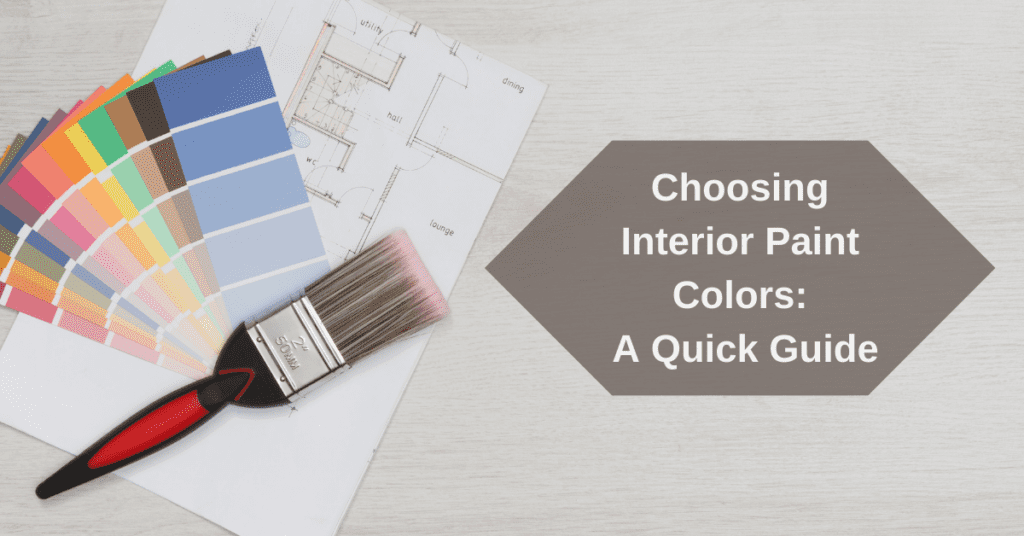Choosing Interior Paint Colors: A Quick Guide

Intro
Are you trying to choose the right interior paint colors for your home? If so, then this guide will help you get started in your decision-making process by giving you some tips that will make things easier.
The Meaning of Color in Decorating
Consideration When Choosing a Paint Color For Your Walls The Amount and Types of Light In the Room. Think About How You Will Feel as Well as Look Colors That Are Best With Natural Wood Trim or Furniture Colors That Work with Multiple Shades of Wood Flooring Accents and Accent Walls Consider Working with Neutral Tones; Adding More Color Next Time When Everything Is Already Painted Wall Covering and Artwork before Paint
Discovering Your Interior Design Style
In decorating, it’s important to first determine what your style is before you start to make any major decisions. This will help you figure out which colors and design elements are best suited for your personality and preferences before you even bring out a paintbrush or rollers. There are many options when it comes to interior design styles, but most can be broken down into these four general types: traditional, contemporary/minimalist, rustic/eclectic and retro/vintage. You may find that there is more than one style in your home or that different rooms have different styles; this is fine as long as everything flows together and is cohesive.
The Meaning of Color in Decorating
In decorating, color plays a vital role in giving your home personality and style. Choosing the right colors can help you express yourself while making the most out of your space. Color also has meaning that goes beyond aesthetics — it can be used to convey emotion, evoke nostalgia or bring about positive change. Of course, interior paint colors are not chosen solely based on their symbolism but because they look good too! So keep this information in mind as you start to consider which colors are best for each room of your house before you get started with painting.
Consideration When Choosing a Paint Color For Your Walls The Amount and Types of Light In the Room
Consider your room’s lighting. Are there any windows and if so, are they east or west facing? Do you have multiple light sources such as lamps and overhead lights in addition to the natural light streaming through the windows? This is important because a room with a lot of natural light will need lighter paint colors for walls while one with dimmer lighting may look better with darker shades. You should also take into account how much artificial light is used in each room — rooms like kitchens, dens and family rooms that often have more appliances running tend to require more illumination which can be accomplished through brighter bulbs, additional fixtures or both. Let’s say your kitchen requires greater candlepower than other areas due to all of its appliances; you can choose paint colors to reflect this, but you will also want to make sure the bulbs you use don’t cast a yellowish reflection.
Think About How You Will Feel as Well as Look Colors That Are Best With Natural Wood Trim or Furniture Colors That Work with Multiple Shades of Wood Flooring Accents and Accent Walls
Take a look at all the woodwork in your home that still has its original finish on it. If it is natural stained, consider which wall colors would work best with that color tone and complimentary furnishings. For example, if you have dark brown stained baseboards, doors and trim throughout the house, then darker neutral tones such as beige or taupe are great choices for the walls. If you have a lighter finish such as light oak throughout the house, then go with a warmer white tone or something in between.
When it comes to hardwood floors and accents, consider working with neutral tones that have a mix of gray or brown tones within them; this makes them look more natural and will work well with interiors where there are multiple shades of wood flooring used. Adding more color next time when everything is already painted can be achieved by using brighter colors for trim and bolder designs on accent wallpapers such as graphic patterns, stripes and florals. This helps make the room feel less bland without having to completely repaint again — just remember how much darker the room will become when you move from light to dark or vice versa.
Consider the Feeling You Want to Create with Your Home Colors That Suggesting Warmth and Liveliness Colors That Suggest Tranquility and Peacefulness
Deciding what kind of feeling you want a room to give you can be difficult, but use your intuition as well as some common color symbolism to help guide you. There is no right or wrong way to go about this — it’s simply choosing the mood that works best for you. Is there a den where you can read in peace? Then choose lighter shades such as sky blue, pale green or light yellow. If the living room should evoke feelings of comfort and warmth, then bolder tones such as orange, red and yellow are better options. If a room is to be used for entertaining guests, then go with colors that project a sense of style such as deep blues and greens.
Think About the Mood You Want in Each Room Colors That Suggest Tranquility and Peacefulness Colors That Suggest Warmth and Liveliness
Deciding what kind of mood you want a room to give you can be difficult, but use your intuition as well as some common color symbolism to help guide you. There is no right or wrong way to go about this — it’s simply choosing the mood that works best for you. Is there a den where you can read in peace? Then choose lighter shades such as sky blue, pale green or light yellow. If the living room should evoke feelings of comfort and warmth, then bolder tones such as orange, red and yellow are better options. If a room is to be used for entertaining guests, then go with colors that project a sense of style such as deep blues and greens.
Think About the Mood You Want in Each Room Colors That Suggest Tranquility and Peacefulness Colors That Suggest Warmth and Liveliness
Deciding what kind of mood you want a room to give you can be difficult, but use your intuition as well as some common color symbolism to help guide you. There is no right or wrong way to go about this — it’s simply choosing the mood that works best for you. Is there a den where you can read in peace? Then choose lighter shades such as sky blue, pale green or light yellow. If the living room should evoke feelings of comfort and warmth, then bolder tones such as orange, red and yellow are better options. If a room is to be used for entertaining guests, then go with colors that project a sense of style such as deep blues and greens.
Think About the Mood You Want in Each Room Colors That Suggest Tranquility and Peacefulness Colors That Suggest Warmth and Liveliness
Deciding what kind of mood you want a room to give you can be difficult, but use your intuition as well as some common color symbolism to help guide you. There is no right or wrong way to go about this — it’s simply choosing the mood that works best for you. Is there a den where you can read in peace? Then choose lighter shades such as sky blue, pale green or light yellow. If the living room should evoke feelings of comfort and warmth, then bolder tones such as orange, red and yellow are better options. If a room is to be used for entertaining guests, then go with colors that project a sense of style such as deep blues and greens.
Think About the Mood You Want in Each Room Colors That Suggest Tranquility and Peacefulness Colors That Suggest Warmth and Liveliness
Deciding what kind of mood you want a room to give you can be difficult, but use your intuition as well as some common color symbolism to help guide you. There is no right or wrong way to go about this — it’s simply choosing the mood that works best for you. Is there a den where you can read in peace? Then choose lighter shades such as sky blue, pale green or light yellow. If the living room should evoke feelings of comfort and warmth, then bolder tones such as orange, red and yellow are better options. If a room is to be used for entertaining guests, then go with colors that project a sense of style such as deep blues and greens.
Conclusion
Color can be a very effective way to establish the mood of each room in your home. Just remember that what works for one person may not create the right atmosphere for you, so it’s important to cultivate a sense of intuition when choosing colors. There’s no “right” or “wrong” way to go about this — just choose the color shades and tones that work best with your personality and lifestyle.
